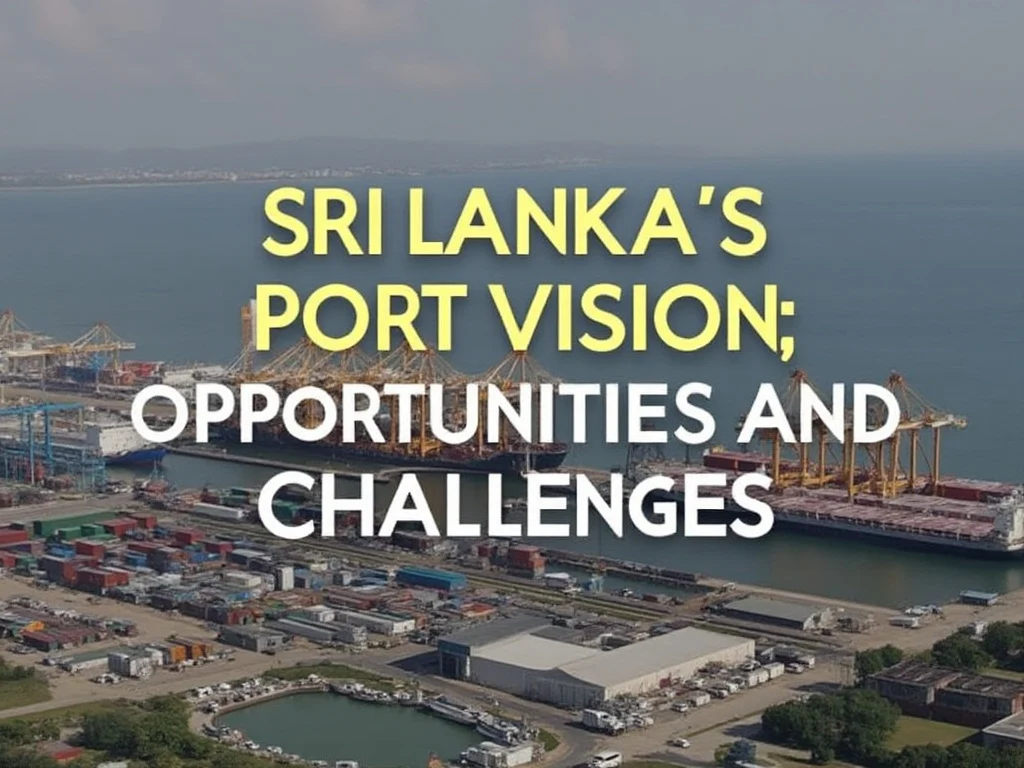Sri Lanka Port Authority's (SLPA) Harbour Master, Capt. Nirmal Silva, has outlined ambitious plans to leverage the country’s strategic location near India to drive growth in its ports and marine industries. While these proposals align with Sri Lanka’s long-term economic goals, their success depends on navigating significant financial, political, and logistical challenges.
Leveraging Proximity to India
Sri Lanka’s geographical location at the crossroads of major shipping routes gives Colombo Port a natural advantage, particularly for transshipment operations catering to Indian cargo. Currently, 84% of Colombo’s total Twenty-Foot Equivalent Units (TEUs) come from transshipment, with Indian trade playing a dominant role.
Colombo’s competitive pricing and proximity offer Indian businesses a cost-effective alternative for transshipment, strengthening Sri Lanka’s position as a key logistics hub. Collaborations, such as the Adani-John Keells partnership in the Colombo West International Terminal (CWIT), further underscore the potential for economic integration between the two nations.
However, India’s aggressive development of domestic ports, including Vizhinjam and Ennore, threatens Colombo’s dominance in the region. Should these ports offer similar pricing and services, Sri Lanka risks losing its competitive edge. Additionally, increasing reliance on Indian investment raises concerns over economic sovereignty and domestic political sensitivities.
Lessons from Singapore
Singapore’s success as a global transshipment hub offers valuable insights for Sri Lanka. Automation, digitization, and world-class infrastructure have made Singapore a model of operational efficiency. Its integrated policies, including free trade agreements and tax incentives, connect port development with broader economic strategies.
For Sri Lanka to emulate Singapore, significant investments in technology and workforce development are essential. However, financial constraints, exacerbated by the nation’s debt crisis, limit the feasibility of large-scale projects like the East Container Terminal (ECT) and CWIT. Furthermore, Sri Lanka faces a skills gap, necessitating a long-term commitment to workforce training to achieve similar levels of efficiency.
Green Energy Potential at Trincomalee
The development of Trincomalee as a green energy hub aligns with global trends and presents a unique opportunity for Sri Lanka to position itself as a renewable energy leader. This vision includes renewable energy projects such as wind and solar farms, coupled with industrial development.
Despite its potential, green energy development faces high initial costs and requires substantial international investment. Competing with established renewable energy hubs in the region, including India, demands aggressive policy incentives and collaboration with global investors to attract the necessary resources.
Diversifying Tourism at Galle Port
Plans to transform Galle Port into a tourism hub with passenger terminals and yacht marinas reflect Sri Lanka’s goal to diversify its economic base. By catering to high-value international tourists, the port aims to tap into the luxury travel market.
However, tourism’s seasonal nature and vulnerability to global disruptions, such as pandemics or economic downturns, present significant risks. The success of this transformation depends on consistent international tourist arrivals and seamless coordination between government and private stakeholders—an area where Sri Lanka has historically struggled.
Challenges in Implementation
Sri Lanka’s ambitious port development plans face several critical challenges:
Financial Constraints
The country’s economic crisis poses a significant obstacle to financing
large-scale projects. While foreign investments, particularly from India,
provide crucial support, excessive reliance on external funding raises concerns
about economic vulnerability and debt sustainability.
Political Sensitivities and
Geopolitical Balancing
Increased dependence on India for port development risks domestic political
backlash over sovereignty concerns. Balancing relations with India and
China—both key players in Sri Lanka’s port sector—requires careful diplomatic
navigation to avoid alienating either nation.
Infrastructure Gaps
Projects such as the CWIT, ECT, and green energy initiatives require robust
supporting infrastructure, including reliable transport networks and energy
supplies. Sri Lanka’s existing infrastructure may struggle to meet these
demands, further complicating project execution.
Regional Competition
Emerging regional hubs like Singapore, Malaysia, and India’s rapidly developing
ports present significant competition. Colombo must differentiate itself by
offering superior services, innovative solutions, and competitive pricing to
retain its strategic advantage.
A Vision for the Future
Sri Lanka’s National Ports Master Plan (NPMP) outlines an ambitious roadmap to transform the country into a regional economic powerhouse by capitalizing on its strategic location. The integration of green energy and tourism initiatives, alongside partnerships with regional players like India and global models like Singapore, offers a pathway for sustainable growth.
However, the success of these proposals depends on addressing financial constraints, navigating political and geopolitical complexities, and ensuring efficient implementation. With strategic planning and effective execution, Sri Lanka could position itself as a pivotal player in South Asian trade and logistics, securing long-term economic benefits.







No comments